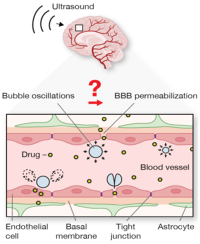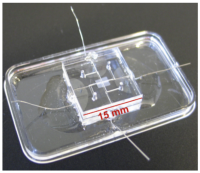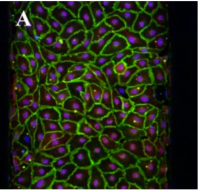Focused ultrasound in combination with microbubbles is a novel method to deliver drugs to the brain (Fig. 1). Although the efficacy of the technique is demonstrated already in clinical trials, the exact mechanism(s) remain unclear. In this project, you can shed light on the correlation between ultrasound driven MHz microbubble oscillations and the permeabilization of a model blood-brain barrier cultured on chip (organ on-chip model).
 The presence of the highly selective, semipermeable blood-brain barrier (BBB) is the main obstacle to the delivery of therapeutics to the central nervous system (CNS). The available drug delivery methods to treat brain diseases lack specificity or are invasive and unreliable. A novel method to deliver drugs to the brain employs gas-filled microbubbles (MB) driven into oscillation by focused ultrasound (FUS). This novel approach is promising as it is non-invasive, transient, and tunable, allowing localized drug delivery that can be monitored through the received bubble echoes. Although the technique's potential is already demonstrated in clinical trials, the exact mechanisms by which the oscillating MBs open the BBB remain unclear. This knowledge gap limits standardization and thereby clinical translation of BBB permeabilization using microbubbles.
The presence of the highly selective, semipermeable blood-brain barrier (BBB) is the main obstacle to the delivery of therapeutics to the central nervous system (CNS). The available drug delivery methods to treat brain diseases lack specificity or are invasive and unreliable. A novel method to deliver drugs to the brain employs gas-filled microbubbles (MB) driven into oscillation by focused ultrasound (FUS). This novel approach is promising as it is non-invasive, transient, and tunable, allowing localized drug delivery that can be monitored through the received bubble echoes. Although the technique's potential is already demonstrated in clinical trials, the exact mechanisms by which the oscillating MBs open the BBB remain unclear. This knowledge gap limits standardization and thereby clinical translation of BBB permeabilization using microbubbles.
 In this Master thesis project, we aim to correlate the ultrasound-driven MBs oscillations to their (bio) effect on endothelial cells. To this end, you will develop a BBB on-chip model (Fig. 2) with electrical sensors to resolve spatiotemporally the changes in barrier properties of the endothelial cells during and after ultrasound-driven microbubble oscillations.
In this Master thesis project, we aim to correlate the ultrasound-driven MBs oscillations to their (bio) effect on endothelial cells. To this end, you will develop a BBB on-chip model (Fig. 2) with electrical sensors to resolve spatiotemporally the changes in barrier properties of the endothelial cells during and after ultrasound-driven microbubble oscillations.

The main goal is to be able to detect and record the changes in the endothelial cell layer in real-time and corelate it to the bubble dynamics. Once you have developed a reproducible on-chip BBB model, you will explore biological responses (e.g., tight junction disruption, Fig. 3) depending on US parameters such as frequency, acoustic pressure, and pulse duration. Next to electrical sensing measurements, you will learn to master experimental methods including ultra-high-speed imaging at 10 million frames per second, confocal imaging, electrical data acquisition and data processing, image processing, and cell culture.

